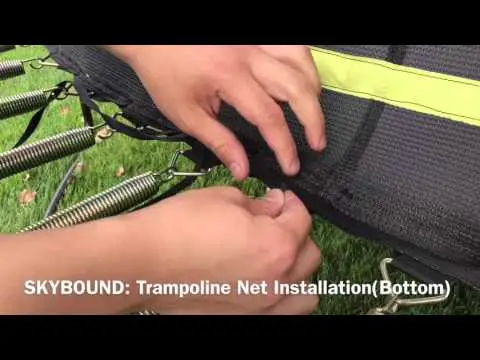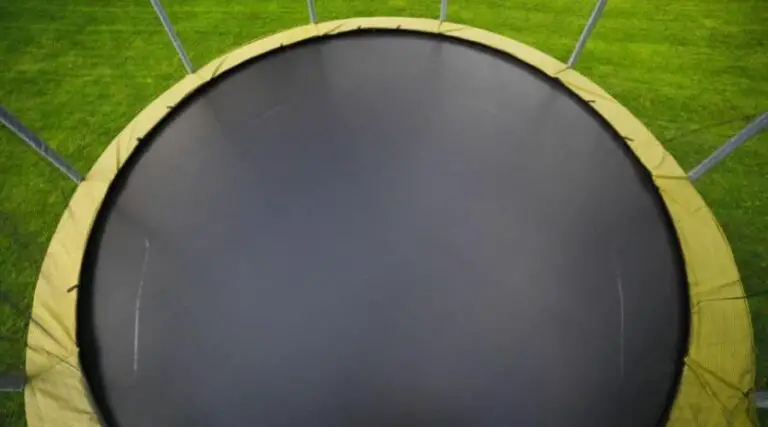Trampolines are a great source of fun and exercise, but they can be a significant investment. It is crucial to take proper care of your trampoline to make sure it lasts for many seasons to come. When the cold winter months approach, trampoline owners often ask, “Should I leave my trampoline outside, or does the snow ruin a trampoline?” This article is written to offer you valuable tips on how to winterize a trampoline, ensuring its longevity despite the harsh winter weather.
The Problem of Leaving Your Trampoline Out in Winter
Leaving your trampoline out in winter can lead to a series of complications. Direct contact with the snow can harm the trampoline’s parts, particularly if you live in an area with heavy snowfall. The weight of the snow can put undue stress on the trampoline’s frame, potentially warping or even breaking it.
Furthermore, moisture trapped beneath a snow cover can promote the growth of mildew and ruin your trampoline. These challenges make winterizing an essential step for all trampoline owners who wish to keep their trampoline safe and operational during the winter months.
How Much Snow Can A Trampoline Hold
A significant consideration when it comes to the capacity of a trampoline to support snow load is the structural integrity and weight-bearing capacity of its frame. The ability of a trampoline to withstand heavy snow depends on factors such as the type of frame material, thickness, and design. To give you an idea, here is a table that shows the weight-bearing capacity of different trampoline frames:
| Frame Material | Weight-Bearing Capacity |
|---|---|
| Steel | 300-400 pounds |
| Aluminum | 200-300 pounds |
| Galvanized Steel | 400-500 pounds |
Knowing the weight-bearing capacity of your trampoline can help determine if it can safely hold the amount of snow in your area. It is important to consider this before deciding whether to leave your trampoline out during winter. In the next section, we will discuss how to remove heavy snow from a trampoline without causing damage.
How to remove heavy snow from a trampoline
Removing heavy snow from a trampoline is essential for ensuring its safety and preventing potential damage. Winter weather conditions can lead to accumulation of snow on the trampoline surface, which can cause the frame to bend or break.
To remove the snow, use a soft-bristle broom or a snow rake to gently push the snow off the trampoline. Avoid using sharp objects or shovels that could damage the trampoline.
It is important to follow safety guidelines for winter trampoline use to prevent accidents and injuries.
Why Winterize Your Trampoline?
Winterizing your trampoline ensures it withstands harsh weather conditions without incurring damage. This process involves preparing your trampoline for the winter season by taking several preventative measures, from disassembling certain parts to using a trampoline cover. When you winterize a trampoline, you reduce the risk of it becoming unusable or unsafe due to ice or snow damage.
How to Winterize a Trampoline?
The first step to winterize a trampoline is to remove any detachable parts such as the enclosure net and jump pad. Carefully untie the net first, and then, take down the poles and disassemble the jump pad.
Store these trampoline parts in a safe and dry place indoors to protect them from the severe winter weather. For the remaining trampoline frame, you can use a trampoline cover to shield it from direct contact with the snow.
Remember, it’s vital to clean the cover regularly with a broom or other tools to prevent the accumulation of snow. Letting snow build up can lead to a heavy weight of snow causing damage to the trampoline structure.
Is it Safe to Jump on a Trampoline in Winter?
Although it might be tempting to use the trampoline in the winter, safety should always be paramount. Cold temperatures can make the trampoline material brittle and more susceptible to cracking or breaking, particularly when jumping.
Nevertheless, if the trampoline is properly winterized and regularly inspected, it’s ok for children to play on the trampoline lightly. Always remember to remove any accumulated snow regularly, and avoid jumping on the trampoline during particularly cold or snowy days.
Trampoline Winter Care: Protecting Your Trampoline Cover
A trampoline cover is a valuable tool for winterizing your trampoline. It protects the trampoline from heavy snow and harsh weather. However, a trampoline cover will trap moisture if not handled correctly, allowing mildew to grow.
To prevent this, ensure the cover is clean and dry before applying it. Moreover, clean the cover regularly to remove accumulated snow and ice. Remember to check the trampoline cover after windy days as high winds may dislodge it.
Preventing Snow Buildup: What to Do with Accumulated Snow?
Heavy snowfall can accumulate on the trampoline, causing damage due to its weight. To prevent this, regularly remove the accumulated snow from the trampoline using tools such as snow blowers or brooms. Be careful not to damage the trampoline in the process.
Never allow the snow to melt on the trampoline, as it goes in contact with water, it can cause corrosion or promote the growth of mold and mildew.
How to Use a Trampoline During Winter?
While many trampoline owners store their trampolines during the winter, if you choose to leave your trampoline outside, there are safe ways to use it. Ensure that the trampoline is properly winterized and free of snow before anyone starts jumping.
Additionally, inspect the surface to ensure that it is not frozen or slippery. You should also instruct children to jump carefully, as the trampoline can be more slippery during the cold season.
Additional Safety Tips for Using Your Trampoline in Winter
Safety is paramount when using your trampoline in winter. Here are some additional tips to keep you safe:
– Use an anchoring kit to secure your trampoline, especially if you live in a windy area.
– Always remove accumulated snow regularly to prevent damage from the weight of the snow.
– Inspect your trampoline frequently to ensure that it is in good condition.
– Use a frame pad to keep snow from getting inside the springs.
Key Elements to Consider for Heavy Snow
If you live in an area with heavy snowfall, consider the impact that the weight of the snow might have on your trampoline. The pressure from heavy snow can lead to permanent deformation of the frame and springs or even break the trampoline.
In such circumstances, it may be beneficial to disassemble the trampoline and store it in a safe and dry place. However, if this isn’t an option, ensure that you are diligent in removing the accumulated snow regularly and monitoring the trampoline’s condition.
Ensuring Your Trampoline’s Longevity: Final Tips on Winterizing
Winterizing your trampoline is an essential step to ensure its longevity. By following the steps outlined in this article, you can protect your investment and continue to enjoy your trampoline for many years to come.
Whether you decide to leave it outside during the winter or store it away, these measures will protect your trampoline from harsh winter weather conditions and ensure it remains safe for use.
Remember to:
– Disassemble and store away removable parts.
– Regularly clean and inspect your trampoline if left outside.
– Use a trampoline cover and frame pad.
– Remove accumulated snow from the trampoline regularly.
– Follow additional safety tips for winter use.
– Consider the weight of heavy snow if you live in a snowy region.
By adhering to these tips, you can ensure that your trampoline will survive the winter months, providing fun and enjoyment when the warmer weather returns.
Conclusion
It is important to properly maintain and protect your trampoline during the winter months. By covering and winterizing your trampoline, you can prevent damage from snow and harsh weather conditions.
It is crucial to remove heavy snow from the trampoline to avoid any potential accidents. Following safety guidelines for winter trampoline use is essential to ensure the well-being of users.
Lastly, storing your trampoline properly when not in use will help prolong its lifespan and keep it in good condition for future use.





